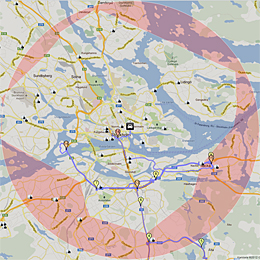A Range Tracker for Electric Cars
NEWS
A major shortcoming of electric cars is drivers’ uncertainty over how far the vehicle can be driven before the battery dies, a phenomenon known as “range anxiety.” But a new Web-based tool developed by KTH researchers promises to show just how far an electric car can go before the charge runs out.

“We’re addressing the problem of range anxiety, both for owners of electric cars and for the media,” says Anders Lundström, a researcher at the Department of Media and Interaction Design at KTH. “The obvious concern would be a driver asking himself ‘Will I be able to make that trip on Saturday?’ But range anxiety can come up even before the electric car purchased.”
Together with several other KTH researchers, Lundström has developed a new tool that provides a simple, graphical map to show how far an electric car can travel on its remaining charge. “Our tool can help prospective buyers make informed decisions about whether an electric car will meet their needs, and it will enable owners to see if they can make it to a specific destination,” he says.

Here’s how it works: The user clicks a point on the map and a geometric figure appears around the point, showing how far it’s possible to drive before the battery is fully discharged. The user then clicks a destination point on the map and a suggested route is displayed. Once a destination is chosen, the geometric display shrinks and the battery strength indicator shows how much charge would be consumed. The user can then continue to add any number of routes until the calculated charge runs out, and it’s also possible to schedule charging stops during a round trip.
“This tool will help you plan your day with an electric car,” Lundström says. “For example, you can see if you have enough charge left to drive home from work, eat and then go to the gym without plugging in, or if you should drive straight from work to the gym.”
Lundström and his colleagues have simulated a variety of scenarios, while also comparing the tool’s and the vehicle’s estimates for power consumption.
“It’s reasonable to assume that our calculations — which take into account external factors other than the battery voltage — can improve the accuracy of estimates for what the battery can deliver in terms of scope. You rarely drive a car only on flat, wind-free roads, and that becomes very evident when you drive an electric car,” Lundström says.
He has a number of ideas about how the technology can be used.
“Besides using it on the Web, we’ve always had in mind that this technology can be used on a screen in the electric car. Of course, smartphones are another possible track,” says Lundström.
He adds that his team has developed a smartphone app, but says it’s still a little too heavy when calculations are complex. For the time being, the interface is in the “cloud,” that is, servers on the Internet.
How long does it take for a driver to get an idea of how far the car can go on one charge? Anders Lundström has the answer.
“You won’t need many minutes to get a reasonable estimate, and that will be confirmed or adjusted as your everyday situations are tested. And then this will be an important support for winter scenarios, weekend activities and longer trips.”
The best seasons for electric cars are fall and spring, when heating and air conditioning use are at a minimum, Lundström adds. Extreme winter cold can reduce battery capacity by more than half.
A number of companies are already showing interest in the technology, including car rental firms and sellers of electric cars. Lundström says he’s gotten calls from potential customers asking if a certain car model can handle the driver’s needs or to help make a decision on renting or buying an electric car.
“There’s a lot going on in Stockholm,” he says. “The Elbil2020 project aims to make the Hammarby suburb a national demonstration city for electric cars and hybrids. Our technology can come in handy there.”
So far, the KTH researchers have worked with the Nissan Leaf electric car, but Lundström says it will be relatively simple to add other models such as Mitsubishi i-MiEV, Tesla Roadster, Peugot iOn and the Volvo C30 Electric.
“The tool handles distances today, and how much energy will theoretically be needed to cover a distance at certain speeds. We’d also like to have more car models, the ability to change power consumption depending on the number of passengers or baggage, air resistance, temperature differences and wind conditions.”
Lundström hopes — and expects – that the technology that will help make electric cars more popular. “That’s the point in researching and developing this tool. It's a pity that potential buyers may reject electric vehicle technology even when it meets their requirements,” he says.
Other researchers in the team include Cristian Bogdan and Philip Kis, and technology consultant Ingvar Olsson of Tritech. Conducted in cooperation with SICS ICE Lab under the leadership of Lennart Fahlén, the research is funded by the StandUp for Energy and EIT ICT Labs.
By Peter Larsson. Edited by Kevin Billinghurst

